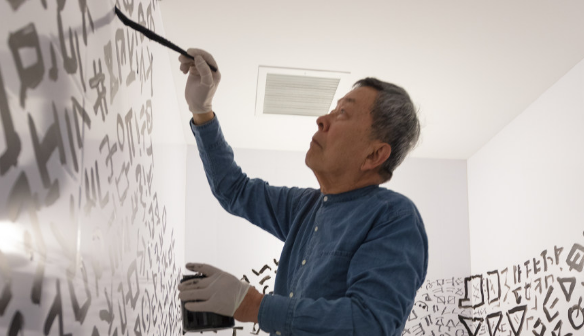Shuji Mukai
February 17, 2017 - November 17, 2019
[]
Installation Views
View Full Gallery
Artist Bio
Shuji Mukai was born in 1940 in Kobe, Japan. He attended the Osaka University of Arts and became acquainted with Gutai artist Sadamasa Motonaga. Because of their connection, at age 19 Mukai was included in the 8th Gutai Art Exhibition at Kyoto Municipal Museum of Art (1959). In 1961 Mukai met Jiro Yoshihara, founder of the Gutai Art Association, and formally joined Gutai as a part of the second-generation of artists. He was the youngest member of the group and participated until Gutai’s breakup in 1972.
Mukai’s work is characterized by an invented, nonsensical visual language comprised of patterns of pictographic signs. His picture space is filled with ○×△ and other various symbols, layered upon each other endlessly. French Informel critic Michel Tapié, gave Mukai very high praise, and Yoshihara once said, “While they appear cool at first glance, there is a furious energy lurking within them.”
During the 2013 Gutai retrospective, Gutai: Splendid Playground, at the Solomon R. Guggenheim Museum, New York, Mukai reenacted his famous Symbol Room from the 8th Gutai Art Exhibition and covered every surface of the museum elevator and bathroom in millions of tiny symbols. Mukai continues to make his architectural interventions. Recent exhibitions of his work include presentations at Hyogo Prefectural Museum of Art, Kobe (2014); Nariwa Museum of Art, Okayama (2014); Karuizawa New Art Museum, Nagano (2014); Palazzo Fortuny, Venice (2015); and Louis Vuitton, New York (2016). Mukai’s work is included in the permanent collections of Museum of Modern Art, New York; National Museum of Art, Osaka; and Hyogo Prefectural Museum, Kobe.

